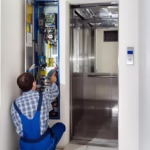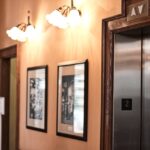Traction elevators are commonly found in high-rise and mid-rise buildings. They use ropes and counterweights instead of hydraulic fluid, making them well-suited for fast and efficient vertical transport. These systems rely on several parts working together, so even a minor problem can delay service or require shutting the elevator down. One of the most common and visible problems is a door malfunction.
When elevator doors don’t open or close properly, it’s more than a small inconvenience. Jammed or slow doors that reopen for no reason can frustrate users and raise safety concerns. Have you ever been in a building where the elevator doors struggled to close or took forever to open? That’s usually a sign something’s going wrong behind the scenes. Knowing what causes these issues and how to respond is the best way to keep your system running safely.
Common Causes of Door Malfunctions in Traction Elevators
Traction elevator doors depend on a mix of mechanical components, electrical systems, and sensors. When one part of that mix isn’t operating right, doors won’t perform as expected. Recognizing the early signs of wear or error can help reduce downtime and extend the life of the elevator.
Mechanical problems are a frequent culprit. Over time, parts like rollers, door shoes, and tracks wear out from constant motion and need replacing or realignment. Misalignment is particularly common in busy buildings, where the doors open and close hundreds of times per day. A slightly off-center door frame can cause friction that slows down operations or makes the doors stick. If ignored, the stress on these components can grow, forcing the entire system to stop for safety reasons.
Electrical issues are another common cause. The control system sends signals that tell the door when to open and shut. When wires are damaged or relays fail, the signal may be disrupted, delayed, or lost. That can cause the doors to move at the wrong time or not at all. A faulty signal could even trigger unintentional openings or closings.
Sensor problems also create disruption. Door sensors are designed to protect passengers, detecting anything that might be in the way. But when sensors collect grime, fall out of calibration, or stop working, they may trigger unnecessarily. Even small disturbances like dust or a sudden shadow can confuse the system and cause repeated opening attempts.
You might be seeing signs like:
- Repetitive door closing and opening before staying shut
- Grinding or squealing sounds when the doors move
- Gaps between the doors when shut
- Doors sticking open only on certain floors
- Long delays before the door reacts to a button press
Catching these warning signs early makes repairs easier and prevents larger issues from developing. If any of these symptoms sound familiar, a professional can inspect the system and help avoid a costly shutdown.
Immediate Steps to Take When Doors Malfunction
When doors start misbehaving, taking swift and safe action matters. It’s better to temporarily pause service than to risk injury or further damage.
Here are the first steps to take:
1. Put the elevator out of service using the panel’s stop or service function. This prevents it from responding to calls.
2. Place clear signs near the elevator on all floors to let people know it’s currently out of operation.
3. Do not attempt to physically move or force the doors. Doing so risks injury and worsens the issue.
4. Check if the door problem is occurring across all floors or limited to specific ones. This detail helps narrow down the issue.
5. Call your elevator service provider right away. Early communication helps get a quicker response.
6. Keep the elevator area clear to prevent further strain on the door and reduce the risk to building occupants.
Resisting the urge to wait and see if the issue goes away can save time, money, and worry. Elevators showing repeat trouble will rarely improve on their own. Taking prompt action ensures a smoother fix and keeps daily traffic moving safely.
Professional Inspection and Repair Processes
Once the elevator is removed from service, a licensed technician will begin the repair process. The first step includes inspecting both mechanical and electrical systems to understand the root of the problem. A panel review can reveal if the problem stems from signal relay failures, faulty power to the doors, or sensor errors.
For mechanical concerns, the technician looks closely at the door components. That includes the tracks, rollers, gibs, and guide rails. Parts that are loose or uneven could be adjusted or replaced completely. Cleaning built-up debris is another common task during door service calls, especially near the tracks and rollers.
Timing adjustments are also key. Doors that close too forcefully or hesitate too long put strain on the system. The door motor or operator may need recalibrating or balancing, which helps everything run at the intended speed and pressure.
During these checks, technicians also assess surrounding parts for signs of bigger issues. For example, if there are problems with floor leveling or outdated control systems, those factors may be contributing to the door’s malfunction. Addressing these early helps prevent repeat service calls down the line.
Preventive care is part of the visit too. A good inspection goes beyond fixing the current issue and points out likely future problems. Spotting early signs of wear lets you schedule cost-effective maintenance rather than urgent repairs.
Preventive Measures for Traction Elevator Door Issues
Routine care offers the best defense against recurring elevator door problems. With a scheduled maintenance plan, your traction elevator system runs smoother and safer, extending service life and reducing unplanned disruptions.
Work with a trusted elevator service partner to create a preventive care program that includes:
- Regular cleaning of sensors, rails, and panels to ensure unobstructed motion
- Lubrication of key hardware like door rollers and tracks to cut down on friction
- Sensitivity tests on reopening devices to confirm safe stopping and reversing
- Alignment checks to make sure doors move in sync without bending or dragging
- Log reviews from control panels to catch historic faults before they return
For older systems, consider upgrading specific door components before they stop working. You don’t always need a full replacement to increase reliability. Improving the sensitivity of sensors, installing updated controllers, or replacing aging door motors can all raise performance and safety without major disruption.
Staying ahead of wear means fewer customer complaints, better compliance with safety standards, and greater trust in your building’s transport systems.
Keep Your Building Running Without the Door Drama
No one wants elevator door delays to become a part of the daily routine. For tenants, guests, and building staff, smooth operation should be expected. Yet too often, small door faults go untreated until they grow into widespread failures.
When traction elevator doors start showing signs of trouble—whether that’s noise, slow movement, or sensor confusion—it’s time to act. Start by pausing elevator use and reporting the problem clearly. Then trust a professional technician to inspect and resolve the issue with care. Done right, repairs don’t just restore performance temporarily—they create lasting improvements in reliability.
Maintenance you can count on adds peace of mind for property managers and everyone who rides the elevator. Paying attention to small problems before they escalate makes a big difference in safety and satisfaction. If your traction elevator system is showing repeat door problems, now’s the time to take action.
To keep your building’s elevator system safe and dependable, prioritizing regular maintenance and addressing issues proactively is key. If you’re looking to maintain the efficiency and reliability of your traction elevator system, Kaiser Elevators has the experience and support you need to keep everything running smoothly.

